
CANBERRA
|
The next day on the tour was a busy one! It included stops at the Canberra Deep Space Communication Complex in Tidbinbilla, a visit to the Canberra Space Dome and Observatory, and a trip out to Mount Stromlo Observatory to see the recovery efforts underway from the devastation of the 2003 bush fires that destroyed much of the complex.
|
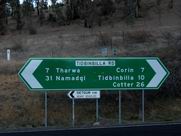
|
As we left Rydges Hotel for Tidbinbilla the weather started out rainy and chilly, but we were all pretty excited about seeing the tracking station at Canberra that's been a huge part of NASA's effort to stay connected with all its spacecraft.
 Rydges Lakeside Rydges Lakeside
|
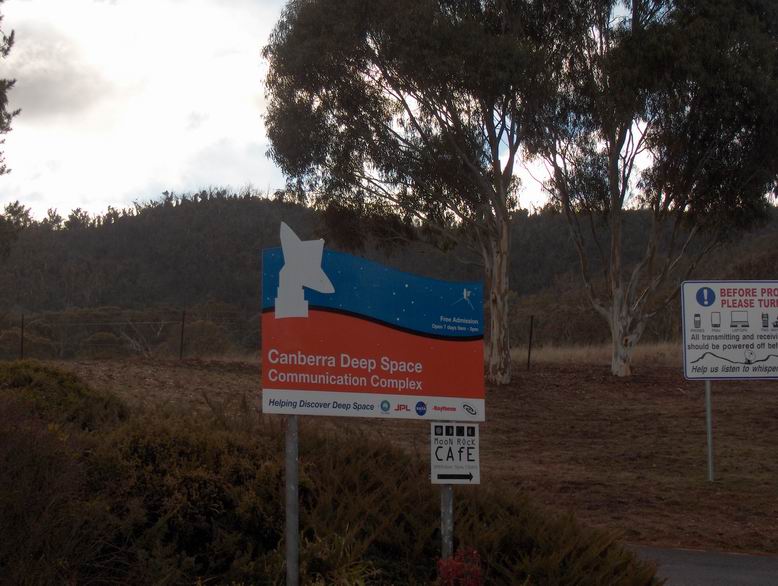
|
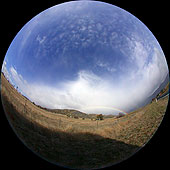
|
Along the way out to the site, which is in a very rural, radio-quiet area, we happened upon a picture-perfect moment. A rainbow appeared over a field full of kangaroos. George stopped the bus, and we all piled out and clicked away. Mark grabbed a hand-held all-sky. Though the kangaroos are too small to see in it, Carolyn's zoom lens did the trick.
 Kangaroo rainbow all-sky site Kangaroo rainbow all-sky site
|
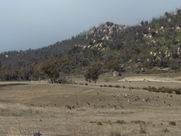
|
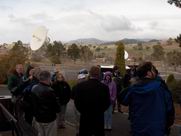
|
Upon our arrival, group members huddled outside the main gate and met our tour guide, a fellow named Glen Nagle. The dish in the background on the left is the 26-meter tracking dish originally used at Honeysuckle Creek to help track the Apollo missions to the Moon.
Glen took us on a tour of the Visitor Centre and out onto a grassy lawn not far from DSS-43, where we all gathered around to hear about the inner workings of the Deep Space Network.
 Canberra Deep Space Communication Complex tour Canberra Deep Space Communication Complex tour
|
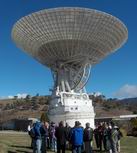
|
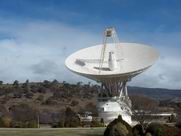
|
This is a nice view of the 70-meter dish from just outside the visitors' center, and a closeup view of just the dish.
|
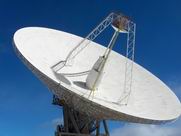
|
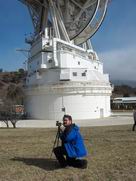
|
We had plenty of time for Mark to get an all-sky shot. He moved back to catch one as the dish moved to a new position tipped down toward us.
We later found out the controllers had seen our group out there with cameras, and were able to move the dish into its best "photogenic" pose for us.
|

|

|
We spent about an hour and a half exploring the Visitors Centre, which has some very nice exhibits, a small theater, and a cafe.
One of the first things you see as you walk in the door is a moon rock exhibit.
|
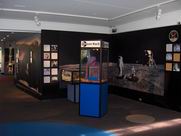
|
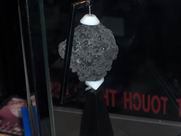
|
Because Tidbinbilla was so instrumental in supporting communications for the Apollo missions, NASA has put one of the largest pieces moon rock on permanent loan for display here.
The data sheet indicates it was retrieved by Buzz Aldrin during the Apollo 11 mission.
|

|
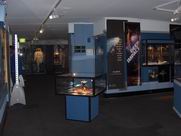
|
Most exhibits deal with the many missions that the Tidbinbilla station supports or has supported in the past. They range from Apollo and Gemini to the current Mars Exploration Rovers and Cassini.
|
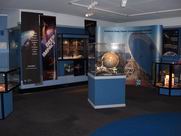
|
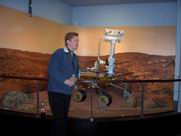
|
Glen Nagle spoke to us about the support the station gives to the Mars Exploration Rovers and the orbiters that relay their information back from the red planet.
The Mars display was a popular posing point.
|

|
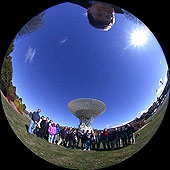
|
Speaking of posing, here's our tour group in front of DSS-43, the 70-metre dish. Our coach driver George even got in the picture — he's the one who snapped the shutter — at the top (in the back).
 Group photo all-sky site Group photo all-sky site
|
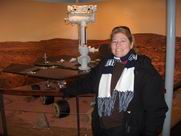
|

|
On our way back into town for lunch, we drove down Anzac Parade, with a view dominated by the Parliament House, the center of Canberra.
We ate at the largest shopping mall in the area — the Canberra Centre "for retail therapy" it calls itself on one of their direction kiosks just inside the entrance. Mall food courts are pretty universal, it seems.
 Canberra Centre Canberra Centre
|
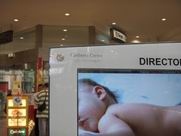
|
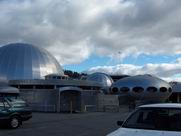
|
Our first stop was the Canberra Space Dome and Observatory. This is a very nice facility featuring a Zeiss projector, fully automated projector systems, and an observatory.
 Canberra Space Dome and Observatory Canberra Space Dome and Observatory
|
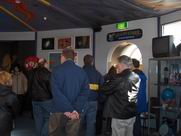
|

|
We spent quite a lot of time in the dome, checking out the star projector and the other systems that the theater uses to present shows.
When we went "backstage," we were pleased to find so many of our shows trayed up and ready to present.
|
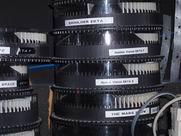
|

|
Unfortunately, due to the shutdown of one its main supporters, a tradesmen's union club, the future of the facility is in doubt, which is a very painful thing for one of the men who helped build it, a friend of ours named Peter Williamson.
Mark and Peter had a chance to catch up with each other. They have been correspondents for years (he's been a good customer of ours!), and we'd spent time with him during the IPS 1998 post-conference tour in England.
It seems a pity that a city like Canberra can't find ways to support such a jewel. Peter's poured his heart and soul into the place.
|
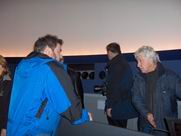
|
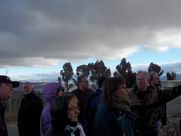
|
Our arrival at Mt Stromlo Observatory was a sobering reminder of the terrible bush fires that roared through the region in January 2003. In the course of a few hours, they destroyed most of the facility &mdash the telescopes and domes, the library and instrument shops, and many astronomers' offices. (For more background and images of those days, go here.) But the buildings that sustained the least damage were the ones perhaps most expendable &mdash the administration offices and the Visitors Centre.
 Mount Stromlo Observatory tour Mount Stromlo Observatory tour
|
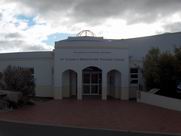
|

|
The first site we visited was the former Yale Columbia dome. It was astonishing just how much devastation a fire could wreak on telescopes.
|

|
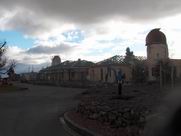
|
The fire flashed over the top of the mountain, gutting the old library buildings and the astronomer's residence. The library is planned for restoration, but the astronomer's residence may just remain the way it is today. It has historical preservation status, which means it can only be restored to its original condition as a residence. But it hadn't been used for that purpose for years (astronomers don't need to live in situ these days), and there are higher priorities for limited reconstruction monies.
|
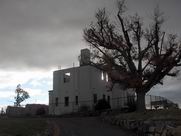
|
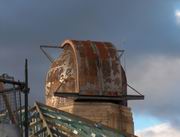
|
The old solar telescope was removed after the fire. The rest of the building is being restored, but it is unlikely this dome will be functional again.
One of the more heartbreaking losses was the Great Melbourne Telescope. Because of light encroachment in Melbourne, it had been moved here in the 1940s, from its site at the Observatory we had seen the previous week.
|
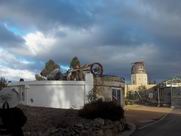
|
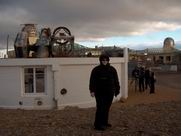
|
We both took some time to inspect the interior of the gutted GMT dome to see the damage wrought by the fire, which took only a few minutes to destroy the facilities.
|
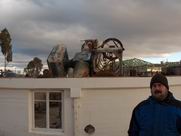
|
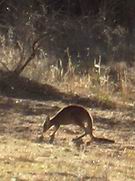
|
Though littered with the remains of gutted observatories, the mountain is far from dead. Life is returning in the form of new plants and mobs of kangaroos. We couldn't tell if this kangaroo mom's joey was in the pouch or not.
New life in the form of domes and equipment is also springing up on Mt. Stromlo. There is a series of new domes and telescopes installed for use in training astronomy students. A center for instrumentation building and data crunching is rising up across the street from the old library buildings.
|
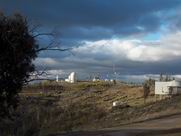
|

|
After our tour we headed into the Visitors Centre to have a catered dinner. It was a good chance for everyone to sit down and catch their breath.
At some point we all found ourselves looking up at a magnificent coelostat in the center of the room.
|
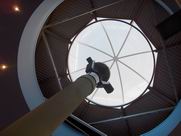
|
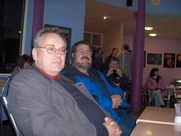
|
Volker and Mark joined the coelostat watchers while dinner was being prepared. Everywhere people were resting, or in Todd Slisher's case, checking images on his digital camera.
Eventually, dinner was served and what a meal it was! We sampled kangaroo, crocodile, quail and emu meat, and seafood crepes. As we did most nights, we decided that a fine local wine would go well with dinner. The chef (who trained in Switzerland) later regaled us with tales of his life as a young man in the Australian outback, and his philosophy of food and cooking.
|
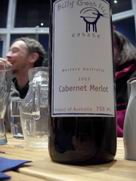
|
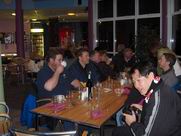
|
It was a very pleasant meal after a sobering tour of the mountain. As we said, there's hope for the mountain. Even the venerable 74-inch telescope (right) may be restored. The building is still structurally sound, so it remains to be seen how it will live again. While the balance of professional observing may shift away from Mt. Stromlo to its sister facilities at Siding Spring, there's still a lot of astronomical life on this mountain.
|
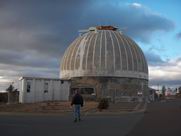
|
|
On our way back to Canberra, we took a little side trip to view at the night lights of the city, from atop a scenic overlook on Mount Ainslie, before returning to our hotel on Lake Burley Griffin (architect Walter Burley Griffin was Canberra's original designer), to prepare for our trip to Parkes.
 Mount Ainslie view Mount Ainslie view
 Rydges Lakeside Rydges Lakeside
|
© Copyright 2006, Loch Ness Productions
Last update: 21 August 2006
|